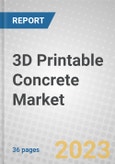The report provides an overview of the global 3D printable concrete market and analyzes market trends. The base year considered for analyses is 2022, while the market estimates and forecasts are given from 2023 to 2028. Revenue forecasts for this period are subdivided based on building type and region. The market estimates are only provided in terms of revenue, USD million.
For preparing accurate quantitative estimates for 2022, we have only included the revenue generated from 3D printable concrete sales within buildings that are greater than 10 meters square or 110 square feet and are situated outdoors. In addition, the walls must have been fully 3D printed. However, qualitative insights and analyses entail all kinds of structures and buildings 3D printed with concrete.
Report includes
- Overview and an up-to-date analysis of the global markets for 3D concrete printing (3DCP)
- Analyses of the global market trends, with historical market revenue data (sales figures) for 2022, estimates for 2023, and projections of compound annual growth rates (CAGRs) through 2028
- Estimate of the actual market size and revenue forecast for the 3DCP market in USD millions, and corresponding market share analysis based on the type of printing, technique, end-use sector and geographic region
- In-depth information (facts and figures) pertaining to the market’s drivers, challenges, opportunities and prospects; the technologies and regulatory scenarios; and the impact of macroeconomic variables on the 3DCP market
- An industry value chain analysis providing a systematic study of key intermediaries involved, with emphasis on manufacturers, raw materials suppliers, 3DCP service providers and the major types of end users
- A look at ESG developments in 3DCP, with emphasis on the importance of ESG, consumer attitudes, risks and opportunities assessment, and ESG practices followed by companies
- An overview of the major vendors in the global 3DCP market, along with an analysis of the structure of the industry, including market shares and recent mergers and acquisitions (M&A) activity
- Patent analysis covering recent patents awarded across each major category
Table of Contents
Executive Summary
3D concrete printing (3DCP), also known as cementitious 3D printing (C3DP), is a type of additive manufacturing technology employed to fabricate buildings and construction components in entirely new shapes and sizes using unique cement-based materials (CBM) called 3D printable concrete. This was not previously possible with conventional concrete formwork. As a result of extensive research and development activities throughout the previous decade, innovative cement-based materials with unique characteristics have been introduced in the 3D printing industry.
Within the process of 3D concrete printing, the cement-based material employed is not conventional concrete. Traditional concrete is unsuitable for 3D printing as it clogs the printer’s nozzle and does not adhere properly to the layers. However, concrete developed for 3D printing applications possesses similar ingredients to conventional concrete, including sand, stone, water, and cement, while maintaining the consistency and texture of an aerated dough.
The specialized cement-bound material displays unique characteristics. It is easy to pump and extrude. It also has the ability to quickly develop an adequate load-bearing capacity in order to bond all the layers together strongly. To attain desired results, specialized training and education is required for all stages of use from material handling to final construction.
D-shape, extrusion-based, and contour crafting concrete printing are popular techniques in the concrete 3DP industry. Among these, extrusion-based concrete printing is the most prominent technology and is exponentially growing in terms of demand worldwide.
3D printable concrete offers unlimited potential in terms of labor cost, material flexibility, operational agility, savings, and design flexibility. The future of 3DP in construction is to take up its freeform buildability benefits into large-scale implementations. However, implementation on a large scale will need the advancement of approaches for printing structural components that adhere to desired flexure and tension.
Companies Mentioned
- Cobod International A/S
- Cybe Construction
- Heidelberg Materials AG
- Holcim
- Icon Technology, Inc.
- Laticrete International, Inc.
- Sika AG
- Xtree
- Yingchuang Building Technique (Shanghai) Co. Ltd. (Winsun)








